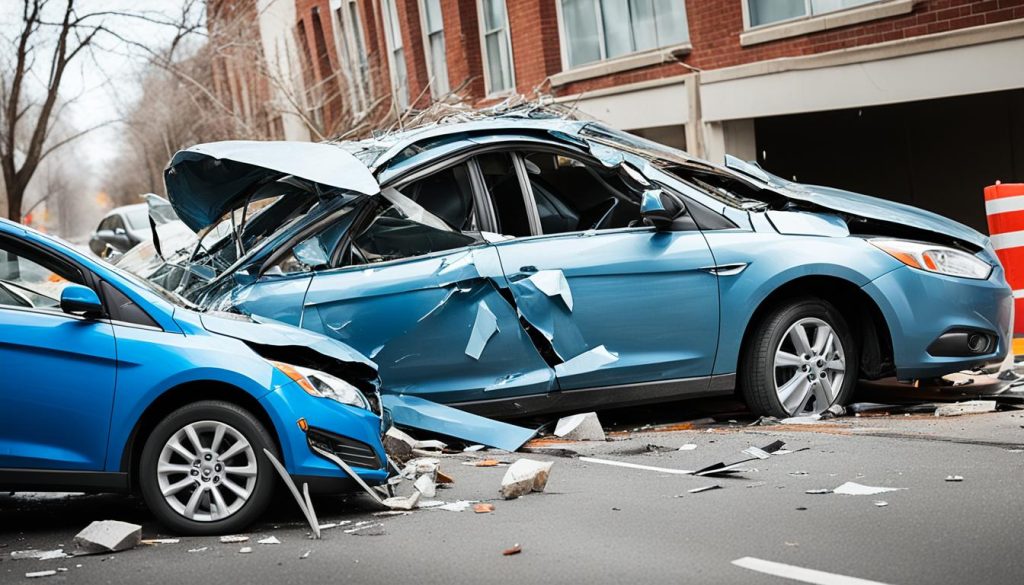In the United States, you must show proof of the minimum auto insurance coverage when registering a vehicle. This guide will give you a full overview of what your state requires for auto insurance. It ensures you know the coverage you need to be legal and safe on the road1.
In Florida, you need proof of Personal Injury Protection (PIP) and Property Damage Liability (PDL) auto insurance before registering your vehicle. PIP covers 80% of your medical costs up to $10,000 if you get hurt in a covered accident. PDL helps protect against damage you or someone driving your car might do to another person’s property2.
To meet Florida’s minimum insurance needs, your car must have at least $10,000 in PIP and $10,000 in PDL coverage. This insurance must come from a Florida-licensed company or a self-insurance certificate. Not having the right insurance can lead to losing your license and registration. You might also face reinstatement fees of up to $5002.
Key Takeaways
- All vehicles registered in Florida must have a minimum of $10,000 in PIP and $10,000 in PDL coverage.
- Proof of insurance must be provided by a Florida-licensed insurer or through a self-insurance certificate.
- Driving without the required coverage can lead to license and registration suspension, as well as reinstatement fees.
- Understanding your state’s minimum insurance requirements is crucial to avoid legal and financial penalties.
- Maintaining the necessary coverage protects you and other drivers on the road in the event of an accident.
Understanding Minimum Auto Insurance Requirements
Most states have set minimum auto insurance coverage that drivers must have. These laws protect drivers and others on the road. It’s important to know these requirements to follow the law and protect your finances3.
Mandatory Coverage
In Florida, drivers must have at least $10,000 in Personal Injury Protection (PIP) and $10,000 in Property Damage Liability (PDL) insurance3. Your PIP covers your medical costs up to $10,000, no matter who caused the accident. PDL pays for damage you cause to another’s vehicle or property.
No-Fault Insurance Explained
Florida is a “no-fault” state for auto insurance. This means your PIP covers your medical costs after an accident, no matter who was at fault3. But, you can still be sued for damages that go beyond the minimum coverage if injuries or damage are severe.
“Understanding the minimum auto insurance requirements in your state is crucial to ensure you are complying with the law and safeguarding yourself financially.”
While the minimums offer basic protection, many suggest getting higher liability coverage for better asset protection in serious accidents. Knowing your state’s auto insurance laws helps you choose the right coverage for your needs and budget3.
Personal Injury Protection (PIP) in Florida
In Florida, personal injury protection (PIP) insurance is key to the state’s auto insurance rules. PIP, or “no-fault” insurance, covers medical costs and lost wages from a car accident, no matter who was to blame456.
What is PIP?
PIP pays for 80% of medical bills, up to $10,000, for those in a covered accident456. It also covers 60% of lost wages and replacement services, also up to $10,000456. PIP is vital in Florida’s auto insurance laws, making sure drivers get medical care and financial help after a crash.
PIP Coverage Limits
Florida requires a minimum of $10,000 in PIP coverage per person456. This covers a lot, like professional medical care, non-emergency treatments, ambulance, rehab, and death benefits5. But for severe injuries, the $10,000 might not be enough, so drivers might need a lawyer to cover their costs5.
Florida’s PIP also covers family members living with the policyholder, passengers, and even pedestrians hit by the driver6. Some companies let you adjust PIP, like upping medical coverage to 100% or skipping lost wages6.
Overall, PIP insurance is crucial for Florida drivers and their families after an accident. Knowing about coverage limits and options helps drivers get the right protection in the state’s no-fault system456.
Property Damage Liability (PDL) Coverage
In Florida, drivers must have property damage liability (PDL) coverage7. This kind of coverage pays for damage you cause to another person’s car or property if you’re at fault in an accident. Florida requires a minimum of $10,000 in PDL coverage8.
This coverage helps you pay for repairs or replacements of the other driver’s damaged items. It covers cars, fences, buildings, and more. Without it, you’d have to pay for these damages yourself.
PDL insurance only covers property damage, not personal injuries8. If the damage is more than $10,000, you might have to pay the extra costs yourself8. Not paying a PDL claim can lead to losing your license in some states8.
Even though PDL coverage is a must in Florida, it doesn’t cover all costs. If the damage is more than your coverage, the other party might sue or use their insurance8.
| Minimum PDL Coverage in Florida | Average Minimum Liability Insurance Cost | Average Full Coverage Insurance Cost |
|---|---|---|
| $10,000 per accident | $134 per month or $1,605 per year | $316 per month or $3,795 per year |
When looking for auto insurance in Florida, compare quotes from different companies. This helps you find the best deals for basic and full coverage7. Your rates can change based on your age, gender, marital status, credit, driving history, location, and the type of car you drive7.
To follow Florida’s insurance laws, you must buy PDL and personal injury protection (PIP) coverage7. Knowing how PDL coverage works and your options helps you protect everyone on the road while meeting the law9.

“Proper insurance coverage is essential for Florida drivers to protect themselves and others on the road. Understanding the minimum requirements, such as PDL, is the first step in ensuring financial responsibility.”
Bodily Injury Liability: An Optional Safeguard
Bodily injury liability (BIL) insurance is not a must-have in Florida, but many experts suggest it10. This type of insurance covers injuries or death to others if you’re legally to blame for an accident10. Even with Florida’s no-fault insurance, you could face a lawsuit for damages over your PIP limits10. BIL can protect your assets if you’re sued and found responsible for serious injuries or deaths from your mistake10.
Why Consider Bodily Injury Liability?
Bodily injury liability insurance is an optional but smart choice for car insurance10. It can shield you from huge lawsuits if you’re at fault in an accident that hurts or kills someone10. In fact, 57% of Progressive customers pick more bodily injury coverage than their state requires11. This shows many drivers see the value in protecting against lawsuits with higher liability limits.
This insurance can cover many costs, like medical bills, lost wages, pain and suffering, and legal fees if you’re sued10. With healthcare costs and legal fights being so expensive, this extra protection can give you peace of mind10.
Florida’s auto insurance laws mainly focus on personal injury protection (PIP) and property damage liability. Yet, many drivers add optional bodily injury liability insurance to their coverage10. This is crucial if you have a lot of assets that could be at risk in a serious crash101112.
State Minimum Auto Insurance Requirements
State-by-State Breakdown
Understanding state minimum auto insurance laws can be tough, but it’s key for drivers to know them. The coverage levels differ a lot across the U.S., from Florida’s low $10,000 PIP and $10,000 PDL to Michigan’s higher $50,000/$100,000 for bodily injury and $25,000 for property damage13.
Many states will soon increase their coverage minimums13. Before January 1, 2025, the usual was $30,000 for one person’s injury or death, $60,000 for two or more, and $20,000 for property damage in one accident13. Starting January 1, 2025, these will go up to $50,000 for one person’s injury or death, $100,000 for two or more, and $25,000 for property damage in one accident13.
Almost every state requires liability coverage in car insurance1. Half of states also need Uninsured/Underinsured Motorist (UM/UIM) coverage, and some require Personal Injury Protection (PIP) coverage1. Maine is the only state needing Medical Payments coverage, and New Hampshire is the only state without a car insurance mandate, but drivers there can pay an annual fee to opt-out1.
| Coverage Type | Average Minimum Requirement Across States |
|---|---|
| Bodily Injury Liability per Person | $27,0832 |
| Bodily Injury Liability per Accident | $54,1672 |
| Property Damage Liability per Accident | $21,6672 |
| Uninsured/Underinsured Motorist Coverage per Person | $28,3332 |
| Uninsured/Underinsured Motorist Coverage per Accident | $56,6672 |
| Personal Injury Protection (PIP) Coverage per Person | $15,0002 |
| Personal Injury Protection (PIP) Coverage per Accident | $30,0002 |
| Medical Payments Coverage | $1,0002 |
Car insurance is mostly mandatory to help victims of accidents caused by insured drivers. It prevents big financial hits on people’s lives1. It’s important for drivers to know their state’s laws to have the right coverage and avoid fines1.

Knowing the state-by-state auto insurance laws helps drivers make smart choices about their coverage. It ensures they meet their state’s legal standards1. This knowledge protects both the driver and other road users1.
Penalties for Lacking Minimum Coverage
Not having auto insurance in Florida can lead to big problems14. You could lose your driver’s license and vehicle registration for up to 3 years14. To get them back, you might have to pay a fee of up to $50014. It’s important to keep your insurance active to avoid these big costs14.
License Suspension Risks
Driving without insurance can get your driver’s license suspended14. If you’re caught driving without insurance while your license is already suspended, you’ll get another six-month suspension14. If you get a third or more conviction for driving without insurance, you’ll need SR-22 insurance for three years14.
Reinstatement Fees
To get your license and registration back after a suspension, you’ll have to pay a fee14. In Illinois, this fee is usually $10015. Also, driving without insurance can make your insurance costs go up, and some companies might not insure you15.
Driving without insurance in Florida has serious consequences16. You could face fines, license suspensions, and fees to get your license back14. It’s key to keep the minimum auto insurance to avoid these risks and stay safe on the road16.

“Driving without insurance can result in severe consequences like revocation of driving privileges, fines, and jail time.”16
Don’t risk driving without insurance. Make sure you have the right coverage to follow Florida’s auto insurance laws and avoid big penalties16.
Other Optional Auto Insurance Coverages
Florida requires auto insurance with Personal Injury Protection (PIP) and Property Damage Liability (PDL). But, there are more options that can protect you financially. These include bodily injury liability, collision, comprehensive coverage, and medical payments insurance17.
Bodily Injury Liability covers you if you’re legally responsible for injuries in an accident17. It’s wise to have coverage limits of $50,000/$100,000 or more17.
Collision Coverage helps pay for damage if your car hits something else17. Comprehensive coverage covers non-collision damages like theft or natural disasters17. Deductibles for this coverage can be $100 to $1,000, with $200 being common17.
Medical Payments Coverage pays for medical bills for you and your passengers, no matter who was at fault17. This is great if you have high deductibles or limited health insurance.
There are more auto insurance choices to think about, like Accidental Death and Dismemberment (AD&D) coverage, and Towing and Labor Coverage17. Extended Transportation Coverage (Rental Reimbursement) and Mechanical Breakdown Coverage are also worth considering17.
State-required minimums offer basic protection, but these extra options give you more financial security and peace of mind17. By picking the right coverages, you can be ready for anything unexpected.
Conclusion
It’s vital for all drivers to know their state’s summary of state minimum auto insurance rules. In Florida, you must have at least $10,000 in PIP and $10,000 in PDL coverage18. Not having this insurance can lead to losing your license and registration, and you’ll face high fees to get them back18. Extra coverages like bodily injury liability can also offer financial protection18.
By understanding your state’s auto insurance laws, you can keep everyone safe on the roads19. You should consider liability coverage, full coverage, GAP insurance, and more. These options help in protecting yourself on the road20.
Getting the right auto insurance is key to protecting your money and your loved ones20. With the right coverage, you can drive with peace of mind. You’ll be ready for anything unexpected.
FAQ
What are the minimum auto insurance requirements in Florida?
In Florida, you must have Personal Injury Protection (PIP) and Property Damage Liability (PDL) insurance to register a vehicle. You need at least ,000 for PIP and ,000 for PDL.
What is Personal Injury Protection (PIP) insurance in Florida?
PIP in Florida covers medical costs and lost wages from car accidents, up to policy limits. It’s a “no-fault” insurance. You get 80% of medical bills and 60% of lost wages, no matter who was at fault.
What is Property Damage Liability (PDL) insurance in Florida?
PDL insurance pays for damages to another’s vehicle or property if you’re at fault. Florida requires a minimum of ,000. This coverage helps pay for repairs or replacements without making you pay out-of-pocket.
Is bodily injury liability insurance required in Florida?
Florida doesn’t require bodily injury liability (BIL) insurance. But, it’s highly advised. BIL covers injuries or death to others if you’re legally liable. Even with no-fault insurance, you could face lawsuits for damages over your PIP limits.
What are the penalties for not having the minimum auto insurance coverage in Florida?
Not having the right auto insurance in Florida has big consequences. You could lose your driver’s license and vehicle registration for up to 3 years. You’ll also have to pay a fee of up to 0 to get them back.
Source Links
- Car Insurance Requirements by State
- State Minimum Car Insurance Requirements – NerdWallet
- Auto insurance guide
- Florida Insurance Requirements
- What is the Minimum PIP Coverage in Florida?
- PIP Insurance in Florida, Explained – NerdWallet
- Florida Car Insurance Requirements
- What Is Property Damage Liability (PDL) Insurance Coverage?
- Automobile Insurance – The Florida Bar
- Bodily Injury Liability Insurance: What Is It? | Liberty Mutual
- How Much Car Insurance Do I Need?
- The Minimum Car Insurance Required In Your State
- § 46.2-472. Coverage of owner’s policy
- Illinois Penalties for Driving Without Valid Insurance
- Penalties for Driving Without Insurance in Illinois | Bankrate
- Driving Without Insurance: Penalties for Every State (2024)
- Consumers – Auto Insurance: Optional Auto Insurance
- Minimum Car Insurance Requirements By State: Complete Guide
- State-Minimum Car Insurance Is Not Enough — Negretti Law
- The Hidden Risks of Minimum-Coverage Car Insurance

